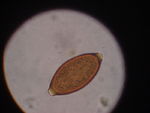Difference between revisions of "Trichuris vulpis"
Jump to navigation
Jump to search
| Line 1: | Line 1: | ||
| + | {{unfinished}} | ||
| + | [[File:Trichuris Egg.jpg|150px|thumb|right|Trichuris vulpis egg - Joel Mills, Wikimedia commons]] | ||
===Overview=== | ===Overview=== | ||
''Thrichuris vulpis''is a typical whipworm in appearance and life cycle. It inhabits the large intestine and ceacum of dogs and less often foxes and cats worldwide. Commonly seen in the caecum, but rarely in large enough quantities to cause clinical signs. | ''Thrichuris vulpis''is a typical whipworm in appearance and life cycle. It inhabits the large intestine and ceacum of dogs and less often foxes and cats worldwide. Commonly seen in the caecum, but rarely in large enough quantities to cause clinical signs. | ||
===Identification=== | ===Identification=== | ||
| − | Adults are between 4.5 and 8cm long. | + | Adults are between 4.5 and 8cm long, slender and white coloured. The anterior end is long and filamentous becoming broader towards the posterior. |
| Line 9: | Line 11: | ||
*It causes intermittent diarrhoea in dogs. | *It causes intermittent diarrhoea in dogs. | ||
*Typical eggs may be shed in faeces, but are not always easy to find, so it may be necessary to examine several repeat samples if infection is suspected.[[Category:Trichinelloidea]][[Category:Dog_Nematodes]] | *Typical eggs may be shed in faeces, but are not always easy to find, so it may be necessary to examine several repeat samples if infection is suspected.[[Category:Trichinelloidea]][[Category:Dog_Nematodes]] | ||
| − | [[Category:To_Do_- | + | [[Category:To_Do_-_NickJ]] |
Revision as of 12:01, 12 July 2010
| This article is still under construction. |
Overview
Thrichuris vulpisis a typical whipworm in appearance and life cycle. It inhabits the large intestine and ceacum of dogs and less often foxes and cats worldwide. Commonly seen in the caecum, but rarely in large enough quantities to cause clinical signs.
Identification
Adults are between 4.5 and 8cm long, slender and white coloured. The anterior end is long and filamentous becoming broader towards the posterior.
- Trichuris vulpis is a typical whipworm in every way.
- It causes intermittent diarrhoea in dogs.
- Typical eggs may be shed in faeces, but are not always easy to find, so it may be necessary to examine several repeat samples if infection is suspected.
